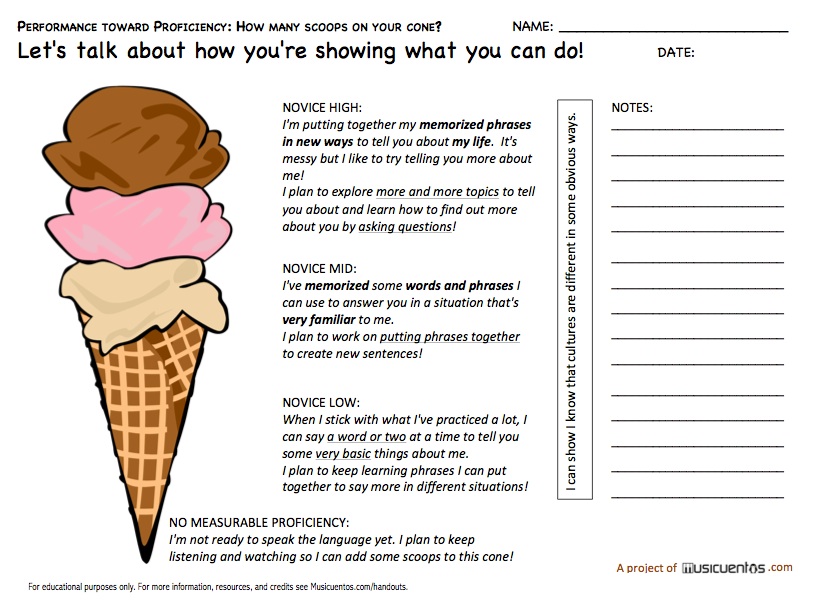It’s possible a good rubric for communicating performance-towards-proficiency for early language learners exists, but if it does, I haven’t seen it. (If you have, please share in a comment!)
See this post for my update from this past summer on my more complex rubric designed to be used with no younger than middle school students. But I don’t teach only older students. The majority of my students are younger than 12 years old. So what does all that proficiency speak mean to them? A wall of text, mostly.
 Necessity is the mother of invention, again. As I prepare to administer my first performance assessment with my early language learners next week, I needed a way to give them feedback. For starters, I needed to get the word rubric off of it – I didn’t know what that meant until college. And I needed an illustrative image. I loved Jen’s idea to make it culturally relevant by using the pyramid Chichén Itzá, but the pyramid was the wrong shape for a rubric in my mind – it’s more like the triangle of a slice of pizza – down at the tip (novice low) you have very little to offer, but as you work your way up the options get broader and deeper (love that advanced stuffed crust!). I’d seen the ice cream cone used as a visual and decided to go with that analogy instead (see an extensive discussion from Alyssa here on Shelby County’s success with implementing the cone and this post by Dorie on how she’s communicating with the ice cream cone; I love it!)
Necessity is the mother of invention, again. As I prepare to administer my first performance assessment with my early language learners next week, I needed a way to give them feedback. For starters, I needed to get the word rubric off of it – I didn’t know what that meant until college. And I needed an illustrative image. I loved Jen’s idea to make it culturally relevant by using the pyramid Chichén Itzá, but the pyramid was the wrong shape for a rubric in my mind – it’s more like the triangle of a slice of pizza – down at the tip (novice low) you have very little to offer, but as you work your way up the options get broader and deeper (love that advanced stuffed crust!). I’d seen the ice cream cone used as a visual and decided to go with that analogy instead (see an extensive discussion from Alyssa here on Shelby County’s success with implementing the cone and this post by Dorie on how she’s communicating with the ice cream cone; I love it!)
This is really basic, but I’m working with six-year-olds. They (and their parents) need some basic feedback on where they’re performing and what they should plan to do next. I’ll have to let you know how it works out actually scoring with it next week. Let me know if you find it useful. The PDF can be downloaded here.
5 Comments
Comments are closed.




In all honesty, I think this would really help even my high schoolers, as I don’t think they’ve dealt with proficiency based language learning before! Wall of text…yes. I think that’s what it is to them.
I know what you mean. 🙂
[…] about proficiency and performance with students is catching on too. Several teachers in other districts have shared how they are using similar visuals to support students in their […]
Thank you for this post and for sharing your PDF with us. This is wonderful! I was just asking a facebook group for input on this and would love to continue the conversation. I taught HS for 4 years and am now at a new school, to a new age group K-6, new to TPRS and CI and am so very excited for this next chapter in my teaching career. I am not used to a grading system in elementary that has, for example, “Solid, Developing, and Beginning”. How do I align/figure out determining grades by matching I Can Statements and ACTFL proficiency levels? My students also haven’t had Spanish in 2 years and so am anticipating using Novice Low I Can Statements for most if not all of our learning goals up through 6th grade.
I agree – I’m not sure how we align levels to school-imposed grading systems when our expectation can’t realistically span more than NL to NM for several years at only 30-60 minutes per week like most elementary teachers have! It’s a little more helpful now that ACTFL has 4 levels in Novice, N1 to N4. And perhaps it’s helpful to have “beginning” at “no measurable proficiency” for the entire first semester and that helps show growth to students and parents in the second semester, for example.